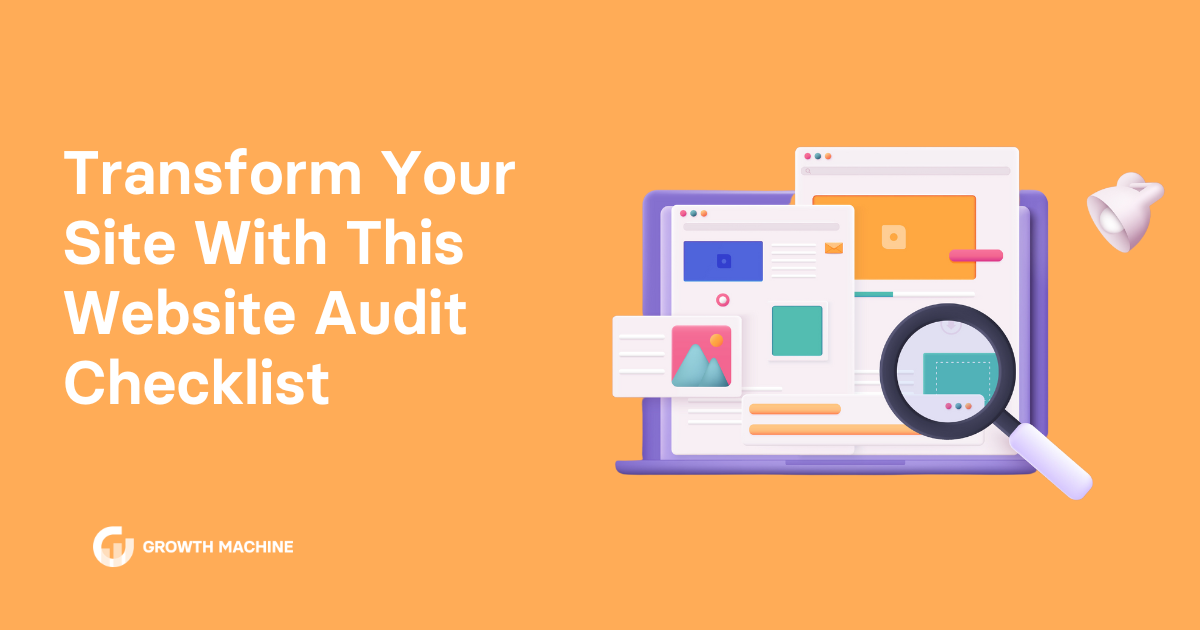Transform Your Site With This Website Audit Checklist
You’ve put in the hard work of creating a website for your business. But maybe you aren’t seeing the traffic you used to, or you feel like your website is lacking in something, but you aren’t sure what.
Every website requires some fine-tuning from time to time, and your website isn’t any different. Instead of guessing which changes you need to make, go through a full website audit checklist to create a website that meets all your customers’ needs.
A website audit checks your site’s vitals and identifies opportunities for improvement. The ultimate goal? Creating a high-quality site that turns more heads — and that plays nice with search engine algorithms.
In this guide, we’ll explain how website audits work, plus give you a comprehensive website audit checklist to simplify your website optimization journey.
What’s the Purpose of a Website Audit?
Think of a website audit as a planned health checkup. During a website audit, you analyze all of the factors that affect your site’s search engine visibility and user experience.
By regularly popping the hood, you can find issues that prevent your site from skyrocketing to the top of the search engine results pages (SERPs) and winning more business.
But it takes a lot of time to audit a website, and you want to make sure you don’t miss anything. That’s why an SEO audit checklist is so important.
A comprehensive website audit checklist:
- Ensures your website meshes with your digital marketing goals
- Helps you rank for the right keywords on every page
- Optimizes your site content and layout to encourage more engagement and conversions
The beauty of a website audit checklist is that it provides structure to the audit process. With the right template, you’ll leave no stone unturned and identify more opportunities to connect with site visitors.
What Should I Include in a Website Audit Checklist?
Every website is different. E-commerce websites might care more about the checkout experience, while a B2B company might care more about their Contact Us page.
However, at a minimum, your website audit checklist should analyze:
- Technical SEO
- On-page SEO
- Off-page SEO
- User experience
- Conversion rates
Your Comprehensive Website Audit Checklist
Ready to give your website a facelift? Run through this five-step checklist at least twice a year to catch errors and find opportunities to build a stronger presence online.
1. Technical SEO Audit
Not to scare you, but the technical SEO audit is the most complex part of the website auditing checklist. But it’s also the most important part of any audit. After all, the quality of your site content doesn’t matter if no one can access your website.
Run through these elements during a technical SEO audit:
- Review your XML sitemap, robots.txt file, and SSL certificate.
- Fix broken links.
- Boost your website performance by checking site speed and load times.
- Check the functionality of your website design on mobile devices.
- Assess your page HTML structure, including your headers, meta tags, and title tags. Don’t forget to add alt text to all image files.
- Optimize your website architecture by confirming canonical URLs and checking for caching issues.
- If you use a content management system (CMS) like WordPress, check that your plugins are up-to-date and working correctly.
Fortunately, you don’t need to be an SEO expert to nail your technical audit. SEO audit tools like Semrush, Ahrefs, Moz, and Screaming Frog can do a lot of the heavy lifting for you.
Of course, this assumes you can make heads or tails of what the site audit tools tell you to do. Growth Machine’s team of SEO experts can conduct a technical audit for you and offer jargon-free recommendations to improve website performance.
2. On-Page SEO Audit Checklist
After completing the technical side of the audit, it’s time to review your website content with an on-page SEO audit. This should include:
- Doing a complete content audit on your most important pages, like your homepage and landing pages.
- Refining content quality. Include external links and internal links on all blogs to boost their search rankings. Add more information or context to create quality content people can’t wait to read.
- Removing duplicate content.
- Refining your meta descriptions and image alt text to include target keywords.
- Reworking your calls-to-action (CTAs) to increase time-on-site and boost conversion rates.
What’s good for search engines is also good for human users, so take the time to assess not only the search engine side of things, but how users perceive your content.
If you’ve changed your brand over the past few years, go through your old content and revive it for today’s readers. That might feel like a hassle if you have a lot of old content, but Growth Machine simplifies the process. We rework your content to meet Google’s EEAT guidelines and scale up content production for serious SEO results.
3. User Experience (UX) Audit
After optimizing the technical elements and content on your site, it’s time to look at the overall user experience. The better experience people have on your site, the more likely they are to stick around and get to know your brand — which can have a big impact on conversion rates.
Go through your website with a fine-toothed comb to check for these factors:
- Analyze the usability of your site. How easy is it for users to navigate on different devices?
- Test your site speed with Google’s PageSpeed Insights. If it’s too slow, work with your developer to speed things up.
- Check the bounce rate for every webpage. If you find a particularly high bounce rate (over 70%), use heatmaps to find points of friction in the user experience.
- Follow the ADA’s guidelines for web accessibility. This includes choosing accessible color palettes, adding captions, and allowing keyboard navigation.
If possible, have an unbiased third-party assess your site’s user experience. It’s easy to get too caught up in your head and easily miss a critical issue on your site.
For example, if you have an e-commerce site and don’t conduct regular test buys, you might overlook problems with the checkout process.
4. Off-Page SEO Audit
While on-page website elements matter for SEO and the user experience, your off-page presence matters, too. In an off-page SEO audit, you look at all the ranking factors that happen outside of your website.
This includes:
- Using SEO audit tools, like Google Search Console, to identify backlinks. Ensure you’re sourcing quality backlinks from reputable websites and disavow any links that could hurt your ranking.
- Posting regularly on social media.
- Creating a linkbuilding strategy to earn more quality links to your website. This includes guest blogging and conducting cold email outreach.
5. Conversion Rate Optimization (CRO) Audit
The final step in the website audit checklist is to optimize your website for conversions. This isn’t mandatory, but CRO will take a good website and make it great — and isn’t that what we all want?
CRO is an entire discipline in and of itself, but these tips will help you find easy wins for boosting conversion rates:
- Conducting split tests (which are also called A/B tests) to see which landing page elements are most effective. Try installing heatmaps to identify the elements that resonate most with your site visitors.
- Checking your site metrics with tools like Google Analytics. If you have a high conversion rate on one page, dissect it to see why that page is so successful.
- Optimizing each webpage for your buyer persona’s pain points.
- Swapping out old images with relevant, helpful graphics.
Boost Organic Traffic With In-Depth Site Audits
Building a website is a lot of work, but maintaining a website is even harder. But an excellent website is a must to encourage lead generation, conversions, and brand authority.
Make the most of your next audit by following this website audit checklist:
- Technical SEO audit
- On-page SEO audit
- Off-page SEO audit
- User experience audit
- CRO audit
If this sounds like a lot of work, that’s because it is! You’re a busy business owner, and you might not have the time or resources to regularly optimize your website. That’s where Growth Machine comes in.
Our team of SEO-obsessed experts executes your vision by conducting keyword research, getting high-authority backlinks, and consistently creating content to boost organic traffic.
Ready to streamline your website? Contact Growth Machine to ace your next website audit.







